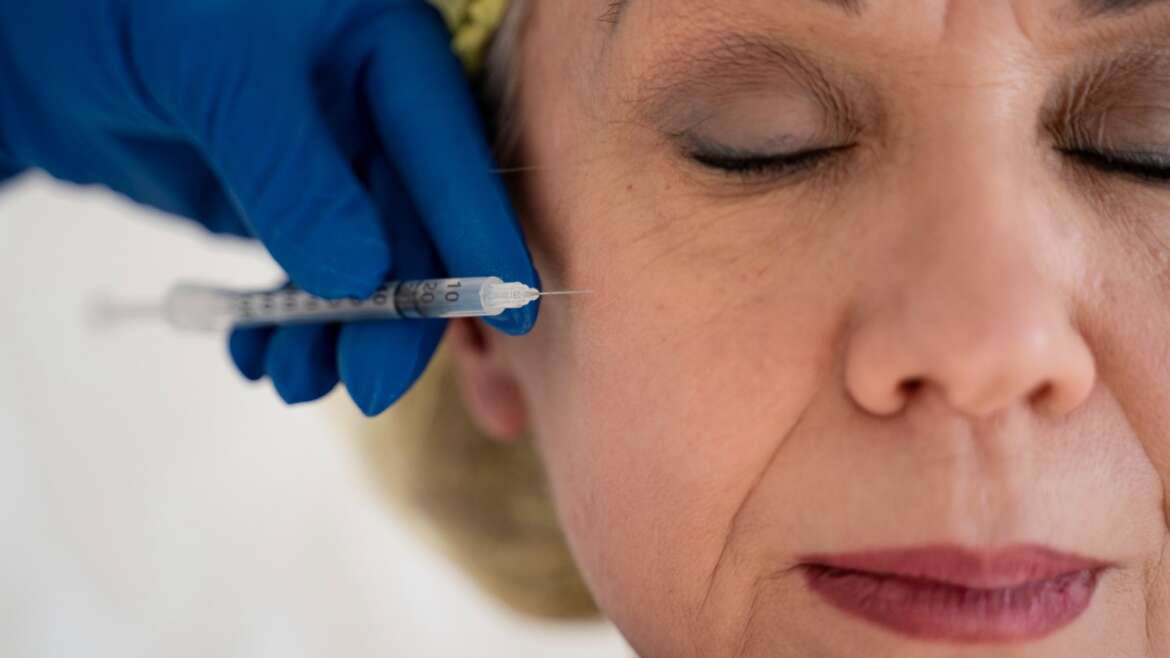Neuromodulator injections have become a popular choice for those seeking to reduce the appearance of fine lines and wrinkles. With well-known brands like Botox, Dysport, Xeomin, and Jeuveau, these treatments offer both cosmetic and therapeutic benefits. In this guide, we’ll walk you through everything you need to know about neuromodulator injections, from how they work to what results you can expect.
What Are Neuromodulator Injections?
Neuromodulator injections are a type of non-surgical cosmetic procedure designed to relax specific facial muscles that contribute to expression lines and wrinkles. The active ingredient in most neuromodulators is botulinum toxin, which temporarily blocks nerve signals, reducing muscle movement. Popular brands include Botox, Dysport, Xeomin, and Jeuveau, each with slight variations in formulation but delivering similar effects.
Neuromodulators are not only effective for aesthetic purposes but also have several therapeutic applications. Beyond wrinkle reduction, these injections are frequently used to manage chronic migraines, reduce excessive sweating (hyperhidrosis), alleviate muscle spasms, and even relieve symptoms of TMJ (temporomandibular joint) disorders. This versatility has made neuromodulators a valuable tool in both cosmetic and medical treatments, providing options for patients seeking functional benefits alongside aesthetic improvements.
How Neuromodulator Injections Work
Neuromodulator injections work by temporarily blocking the release of acetylcholine, a neurotransmitter that prompts muscle contractions. Once injected, the neuromodulator binds to the nerve endings in the targeted muscle area, preventing acetylcholine from reaching muscle cells. Without this signal, the muscle remains in a relaxed state, which softens lines and wrinkles caused by repetitive facial movements, such as smiling, frowning, or squinting.
The results typically become noticeable within a few days as the muscles gradually respond to the blocked nerve signals. Maximum effect is usually reached around two weeks after treatment, with results that can last three to six months, depending on the patient’s individual response and the specific product used. Over time, regular injections can also have a preventative effect, as continuous relaxation of the treated muscles can delay the formation of deeper lines, making neuromodulators an effective option for those looking to maintain a youthful appearance.
Benefits of Neuromodulator Injections
Neuromodulator injections offer a range of benefits, from cosmetic enhancements to therapeutic relief. Here’s a closer look at some of the key advantages they provide, both in appearance and in managing certain medical conditions.
- Reduces Fine Lines and Wrinkles: Neuromodulators smooth out facial lines and wrinkles.
- Prevents New Wrinkles from Forming: Regular treatments can prevent deeper lines from forming.
- Therapeutic Uses: Some people benefit from neuromodulators to alleviate chronic migraines, reduce excessive sweating, and relieve TMJ (temporomandibular joint) pain.
Popular Treatment Areas
Neuromodulator injections are highly versatile and can be tailored to address specific areas of the face and neck. By targeting muscles that contribute to common expression lines and signs of aging, these treatments create a smoother, more youthful look while preserving natural movement. Here’s an overview of the most popular areas where neuromodulators are commonly applied and the unique benefits each treatment provides.
Forehead Lines
Neuromodulator injections effectively reduce horizontal lines across the forehead, creating a smoother, more relaxed appearance. These lines, often caused by repeated expressions over time, can make the face appear tense or aged, but targeted injections soften them significantly.
Related: How to Eliminate Forehead Aging Signs Quickly
Crow’s Feet
Injections around the eyes help smooth out the fine lines known as crow’s feet, which are common signs of aging that appear with frequent smiling or squinting. This treatment restores a youthful look without impacting natural facial expressions.
Frown Lines (Glabellar Lines)
Neuromodulators are widely used to soften frown lines, or the “11 lines,” that form between the eyebrows. Reducing these lines creates a more approachable, less stressed appearance.
Jawline and Neck
Neuromodulator treatments can help contour the jawline, relieve muscle tension, and reduce the appearance of neck bands, providing a smoother profile and more defined facial shape.
Under-Eye and Chin
Though newer, injections under the eyes and in the chin are gaining popularity. They create softer expressions, reduce the look of hollowing, and provide a subtle lift, enhancing overall facial harmony.
What to Expect During the Procedure
The procedure typically starts with a consultation, where a provider assesses your skin, muscle activity, and cosmetic goals. During the treatment, they may apply a numbing cream for added comfort. Using a fine needle, the provider will make several small injections in the target areas. Each session takes about 10-15 minutes, making it a convenient lunchtime treatment with minimal discomfort.
Recovery and Aftercare
Neuromodulator injections generally have minimal downtime. Mild redness, swelling, or bruising at the injection sites can occur but usually resolves within a day or two. It’s recommended to avoid strenuous activities, excessive sun exposure, and facial massages for the first 24-48 hours to ensure optimal results. Lightly cleansing and moisturizing the skin can help speed up the healing process.
When Will You See Results, and How Long Do They Last?
Most patients start to notice results within 3 to 5 days post-treatment, with full effects visible after two weeks. Neuromodulator results can last between 3 to 6 months, depending on the treatment area, product used, and individual factors. Regular treatments can help maintain results and prevent wrinkles from reappearing.
To optimize and prolong the effects of neuromodulator injections, many practitioners recommend scheduling follow-up appointments before the results completely fade. This proactive approach not only helps maintain the desired aesthetic but also allows for adjustments to be made based on changes in muscle activity or facial dynamics over time.
Additionally, maintaining a consistent skincare routine and practicing healthy lifestyle habits can support overall skin health and enhance the longevity of your treatment results.
Side Effects and Risks
While neuromodulator injections are generally safe, mild side effects like temporary redness, swelling, or bruising at the injection sites are common. Rare complications include drooping eyelids (ptosis) or asymmetry if the product migrates. Choosing a qualified, experienced injector significantly reduces these risks.
Are You a Good Candidate for Neuromodulator Injections?
Neuromodulators are suitable for most adults looking to reduce the appearance of dynamic wrinkles or prevent early signs of aging. However, individuals who are pregnant, breastfeeding, or have specific neurological conditions should avoid neuromodulators. A consultation with a qualified practitioner will help determine if this treatment is right for you.
Neuromodulators vs. Dermal Fillers: What’s the Difference?
Neuromodulators and dermal fillers are both popular cosmetic treatments, but they serve different purposes in enhancing facial aesthetics. Neuromodulators, such as Botox and Dysport, are designed to target dynamic wrinkles caused by muscle movement. They work by temporarily relaxing the muscles responsible for these expression lines, resulting in a smoother and more youthful appearance. In contrast, dermal fillers, like Juvederm and Restylane, focus on restoring lost volume and enhancing facial contours, filling in static wrinkles, and plumping areas that have sagged over time.
Key Differences:
- Neuromodulators:
- Target dynamic wrinkles (e.g., frown lines, crow’s feet).
- Temporarily relax muscles to smooth out expression lines.
- Dermal Fillers:
- Restore lost volume in areas such as cheeks, lips, and under the eyes.
- Fill in static wrinkles and enhance facial contours.
Combining both treatments, often referred to as a “Soft Lift”, can provide a comprehensive anti-aging solution, addressing multiple signs of aging for a rejuvenated look.
Related: A Beginner’s Guide to Dermal Fillers
Average Cost of Neuromodulator Injections
The cost of neuromodulator injections varies depending on the brand, number of units required, and geographic location. On average, treatments range from $300 to $600.
Frequently Asked Questions About Neuromodulator Injections
- Will my face look “frozen”? When administered by an experienced provider, neuromodulators should create a natural look, maintaining facial expression while softening lines.
- How often should I get neuromodulator injections? Most patients repeat treatments every 3 to 6 months to maintain results.
- Can I combine neuromodulators with other treatments? Yes, many patients combine neuromodulators with dermal fillers, laser treatments, or microneedling for comprehensive skin rejuvenation.
The Future of Neuromodulator Treatments
Advances in neuromodulators are bringing forth longer-lasting formulations, faster-acting products, and innovative applications. Research is ongoing into new treatment areas, including finer, customizable doses for precise wrinkle reduction and treatments for even broader therapeutic conditions.
Neuromodulator injections offer a versatile, minimally invasive solution to combat wrinkles and provide a youthful appearance. Whether you’re looking to reduce expression lines or explore therapeutic benefits, feel free to schedule a consultation so our professionals can guide you in achieving the best results tailored to your needs. Our plastic surgery clinic is located in Barrie, just 40 minutes north of Toronto.

